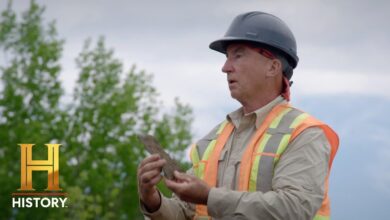SECRETS REVEALED Within Buried Well on Lot 11 | The Curse of Oak Island (Season 10)
SECRETS REVEALED Within Buried Well on Lot 11 | The Curse of Oak Island (Season 10)

Come on in, Bill.
Probably about here, all right.
Rick and Alex Lagina along with Billy Gerhart arrive on Lot 11 near the northern edge of the triangle-shaped swamp.
“I’d work from the outside in so we don’t tear it up, all right?”
Having been given the location of a reported well by Tom Nolan, they are eager to excavate the feature and look for clues that might help solve the 228-year-old mystery.
“Another little mini treasure hunt for you, Gary.”
“Oh wow.”
As you well know, Fred did not have a metal detector. It wasn’t, you know, a proponent of that, so we may find something here.
“Okay, first let’s figure out the extent of the well and then go from there.”
“Yep.”
As Billy Gerhart removes muck and earth in an effort to uncover the well, Gary will scan the spoils for signs of artifacts and potential valuables.
“Thank you.”
“Going in.”
“Foreign.”
“It’s a beauty as well. Look.”
“These are all… Yeah, look at that. Look at the end on it. Yeah, it’s a Rose head for sure.”
“Imagine, the last person to touch that before us might have been the person who dug that well.”
“Yeah, yeah.”
A Rose head spike, meaning that it was hand-forged sometime prior to the discovery of The Money Pit in 1795.
But if so, how might it be related to the buried well that Fred Nolan discovered here more than four decades ago?
“Brilliant. Oh my God, that’s a thing of beauty and in the top couple feet too.”
“Yeah, the question is, what would you be doing here to necessitate using that?”
“Yeah, it is a really old iron fastener. It’s not only a fastener, it’s a big fastener.”
“Right. Yeah, no, this is… You’d think tunneling or shafts.”
“Yeah, yeah. A beautiful flower.”
“I’m gonna bag it and I’ll recheck the spoils there, see if we’ve got any more.”
“Perfect.”
I don’t know what to make of the Rose head spike that’s in close proximity to the hidden well.
We have found those in The Money Pit.
We have found those in Smith’s Cove.
We know for certain they have been highly manipulated by the hand of man, so that’s interesting and intriguing in and of itself.
“Nothing yet.”
“So are there other structures in proximity?”
“There may be.”
“To what end, we don’t know quite yet.”
[Music]
“Looks like it could be modern.”
“Uh-oh.”
“Maybe I am wrong about that.”
“It’s singing!”
“Look what we got!”
“Look at this!”
“The oak!”
“An old look as well, but a look of it maybe it was a… Oak, connected when they were bringing the water out the well.”
“Yeah.”
“They could be.”
“Yeah, yeah.”
“That looks really old.”
“That’s an end-forged up. Yeah, you can kind of see the striations on the point.”
“We have found another Rook on the island, remember that Bunkhook, but Carmen ID is from the 1600s. Same date range would be nice or even older.”
“Mm-hmm.”
“Oh my goodness, the hell is that?”
Earlier this year, while investigating Lot 8 less than a quarter mile to the west, Gary and Marty Lagina unearthed a 17th-century bunk hook, a tool specifically designed for lifting heavy cargo.
Another good candidate for the lab.
“Yep.”
Is it possible that Gary has found a similar artifact near the reported buried well?
“Pentacles will show it to Carmen Lake and hopefully he’ll know what this was used for.”
“All right, I’m gonna bag it.”
“Absolutely.”
“Yeah, I see. Keep digging, Bill.”
“Yep.”
“But I just don’t understand that. Tom said you’ll see the stones. Problem is, there’s no rock.”
“Yeah, there’s no rock.”
“There doesn’t seem to be a well.”
“No.”
“To me, this looks like backfilled stuff. Stone to be found?”
“No.”
“Nothing on this side at all.”
“Okay, we’re done.”
“So I think what we’ll do is bring Tom in and see what he says. If there’s a well, I think, unfortunately, it might be… It could be deeper, but we’re below Tom’s two feet now.”
“All the more reason to stand down and see if Tom has some answers.”
“We have to get more information from Tom.”
“Yep.”
“Yeah, back at it when Tom gets here.”
“Okay.”
“You’ve got to be patient in this place.”
“Yeah, God, Mike. Thanks for coming out.”
“No problem.”
Gary Drayton and Billy Gerhart meet with blacksmithing expert Carmen Legg at the research center to get his analysis of the iron hook that was recovered from the area two days ago.
“We were excavating this area where there’s an old well at the side of the swamp. This is one of the artifacts we found. It’s an oak, but it’s unusual where it’s long and closed in and hopefully you can shed some light on that, mate.”
“Kind of remind me of a block and tackle, you know, it’s the long—”
“Yes, yes. Sorry, you can see how it’s a fairly long shank here.”
“You’re right, Billy. This is from a block and tackle.”
The reason why they had a long shank was because it would hang naturally down from a block and tackle.
Originally invented by the Greek scientist Archimedes in 250 BC, a block and tackle is a pulley device used to manually raise and lower large heavy objects.
“This was made in such a way that it would come off easy and go on easy, so it was a fast operation happening here. Lowering and raising something.”
“Well, it is a well. Would it have been an oak for lowering a book into the well, up and down?”
“No, this was for something heavier.”
“This is much heavier.”
“Yeah, you wouldn’t use something like this, and I can sort of see how thin it is down at the bottom here. So that indicates that it was a lot of use, a lot of use. Might have dragged something over the ground and then raised it and lowered it.”
“Any idea on an age of this artifact?”
“Again, it is very old, Gary. Hooks in a later time period are more around or not elongated like that. So, a hook like that using block and tackle, we’re talking about 1650 to about 1690, no later than 1690.”
“Wow, that’s brilliant.”
A hook used for lifting heavy cargo and dating to more than a century prior to the discovery of The Money Pit in 1795.
“Wow, that is massive.”
“That’s… That’s a big boulder.”
Three years ago, while investigating a curious formation of boulders at the so-called Eye of the Swamp, which is located less than 100 yards from the site of the reported buried well, the team uncovered backfilled organic materials that Dr. Ian Spooner dated to 1680.
“Yeah, that’s a mystery in that world.”
“Yeah.”
Is it possible that the well was built by the same people who were digging at the Eye of the Swamp, and if so, could this hook offer evidence that the well may have been used to hide cargo of great importance or value?
“There’s some activity involved with that, and well, at one time, it was used in that well area.”
“That’s brilliant. Yeah, I know that’s great.”
“Yeah, talking about it has got me hooked, mate.”
“All right, mate. Thanks for coming out, really appreciate it.”
“Very good. See you later.”
“Thank you.”







